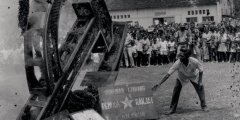CIA Denial in the Media
"In interviews with The New York Times, Mr. Lydman, Mr. Masters and the two senior C.I.A. officials in Jakarta at the time of the coup denied any involvement in Mr. Martens's action. (...) The article also said that William Colby, a former Director of Central Intelligence who headed the C.I.A.'s Far East division in 1965, ''compared the embassy's campaign to identify the P.K.I. leadership to the C.I.A.'s controversial Phoenix Program in Vietnam.'' Phoenix was a C.I.A.-sponsored effort to identify Communist agents within the South Vietnamese civilian population, some of whom were later killed by South Vietnamese Army units. Mr. Colby said in a telephone interview that his remarks were ''misappropriated.'' He noted that he had repeatedly stated publicly that the C.I.A. had no covert involvement in the Indonesian coup or its aftermath." C.I.A. Tie Asserted in Indonesia Purge, July 12, 1990 (page 2 of 2), The New York Times
|
|
|
|
|
|
|
The US' Dirty History in Indonesia
"Without any doubt, the WWII Holocaust and the 1915 Armenian genocide consist the two largest mass slaughters of the 20th century. They are crimes which must never be erased from the collective memory of the peoples, no matter how many decades will pass. However, there are also less known sides of History, the “forgotten” holocausts to which the bourgeois historiography has given little importance, either by downgrading them as insignificant details of world history or by distorting their true dimensions. A major example of such a “forgotten” holocaust is the mass slaughter of the communists in Indonesia by Suharto’s dictatorship during the 1965-66. The criminal called General Suharto was the man who, with the tolerance and silence of the U.S. and British governments, was responsible for one of the most barbaric bloodshed of the previous century: the mass slaughter of more than 1,000,000 people, mostly communists, members and supporters of the Communist Party of Indonesia [1]." The forgotten holocaust: The 1965-66 massacre against Indonesia’s communists, Fact.International
"Declassified files have revealed new details of US government knowledge and support of an Indonesian army extermination campaign that killed several hundred thousand civilians during anti-communist hysteria in the mid-1960s. The thousands of files from the US Embassy in Jakarta covering 1963-66 were made public Tuesday after a declassification review that began under the Obama administration. The Associated Press reviewed key documents in the collection in advance of their release." US knew about 1960s mass killings of communists in Indonesia, declassified documents reveal, 2017, Wright, The Independent
The Look of Silence (Indonesian: Senyap, "Silence") is a 2014 internationally co-produced documentary film directed by Joshua Oppenheimer about the Indonesian killings of 1965–66. The film is a companion piece[3] to Oppenheimer's 2012 documentary The Act of Killing. It was executive produced by Werner Herzog, Errol Morris, and Andre Singer.[4] It was nominated for the Academy Award for Best Documentary Feature at the 88th Academy Awards.[5] Wikipedia
|
|
|
|
|
|
|
|
|
From British/Dutch to American Influence in Indonesia
"In 1957, an assassination attempt was made against Sukarno. Although the actual perpetrators were unknown at the time, both Sukarno and the CIA jumped to use this for propaganda purposes. The CIA was quick to blame the PKI. Sukarno, however, blamed the Dutch, and used this as the excuse to seize all former Dutch holdings, including shipping and flying lines. Sukarno vowed to drive the Dutch out of West Irian. He had already tried settling the long-standing dispute over that territory through the United Nations, but the vote fell shy of the needed two-thirds majority to set up a commission to force the Dutch to sit down with the Indonesians. The assassination attempt provided a much needed excuse for action. The victories of the Communists, infighting in the army, and the 1957 nationalization of former Dutch holdings, led to a situation of grave concern to American business interests, notably the oil and rubber industries. The CIA eagerly pitched in, helping to foment rebellion between the outer, resource rich, islands, and the central government based in Jakarta, Java. Rockefeller Interests in IndonesiaTwo prominent American-based oil companies doing business in Indonesia at this time were of the Rockefeller-controlled Standard Oil family: Stanvac (jointly held by Standard Oil of New Jersey and Socony Mobil-Socony being Standard Oil of New York), and Caltex, (jointly held by Standard Oil of California and Texaco.) In Part I of this article we showed how heavily loaded the Freeport Sulphur board was with Rockefeller family and allies. Recall that Augustus C. Long was a board member of Freeport while serving as Chairman of Texaco for many years. Long becomes more and more interesting as the story develops. 1958: CIA vs. Sukarno"I think its time we held Sukarno's feet to the fire," said Frank Wisner, then Deputy Director of Plans for the CIA, in 1956. By 1958, having failed to buy the government through the election process, the CIA was fomenting a full-fledged operation in Indonesia. Operation Hike, as it was called, involved the arming and training of tens of thousands of Indonesians as well as "mercenaries" to launch attacks in the hope of bringing down Sukarno." JFK, Indonesia, CIA & Freeport Sulphur, by Lisa Pease
|
|
|
|
|
|
|
|
|

Source: Article/Site below
A Tribunal for Indonesia?
|
